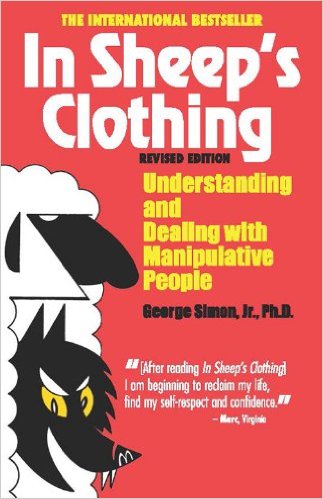
No matter who you are, a businessman, therapist, or school teacher, in time will find your life impacted my those who would try to manipulate you. Some people use manipulation in rare instances to gain temporarily advantage. However, others will often manipulate, often without others knowledge. To that end, it is important to understand the traits of manipulative people and to learn their techniques. George Simon has created the book, In Sheep’s Clothing: Understanding and Dealing with Manipulative People, for therapists and non-therapists alike to understand and learn to survive around manipulative people.
Traits of Manipulative People
Simon begins by describing the traits and characteristics of manipulative people. He often describes manipulators as “covert-aggressive,” as they above else, focus on the desire to win by using cloaked, covert means. Often it is hard to spot a covert-aggressive as they will often appear as charming, socially pleasant people. Only when one gets to known them do they discover something is “not right” about them, usually when it is too late, and they have already been manipulated. Simon makes the point to distinguish covert-aggressive from passive aggressive, as a passive-aggressive is passive, and will not plot or plan methods to manipulate. When a situation comes around, a passive-aggressive will show aggression by defying the will of their target, but will not actively create plans or schemes to gain an advantage. A covert-aggressive will plot, plan, and scheme methods to gain an advantage regardless of the pain and misery others will feel. Winning is the motivating factor, and for a covert-aggressive, the ends justify the means.
Real World Examples
Simon does an excellent job in giving real world examples to show the different kinds of covert-aggressive tactics. From the father who pushes his daughter to make all A’s to fuel his pride, to the minister who’s “service to God” is a reflection of his status and power, to the child who manipulates her parents to negate responsibility, these examples serve to show just how a manipulator manipulates. Simon gives a scenario, a real world example from his therapeutic past, and then breaks it down and shows the different tactics of manipulation used. This allows the reader to understand the various tactics of manipulation, and empowering them to start looking for these tactics in their lives.
Manipulation Tactics
Simon goes into the various tactics of manipulators, from guilt-tripping to victimization. Below is a list of many of the tactics of manipulators, with a brief explanation.
Guilt-Tripping: The manipulator will guilt the victim into feeling as if they are the injured party, or that something bad will occur if they do not give in. This is a button often pushed by manipulators.
Shaming: The manipulator will show just how bad others will feel about their lack of action, and will make the person feel as if they should be scorned by their inaction.
Victimization: As the victim tells the manipulator how they do not wish to be manipulated, the manipulator will switch roles and become the victim, the injured party, and will pout and shame until his needs are met.
Rationalization: The manipulator will give logical, realistic examples as to they their needs matter most, and are for the good of all.
Surviving Manipulation
By recognizing the tools a manipulator uses, Simon gives the reader a framework to better survive and deal with manipulators. When dealing with a manipulator, be on the lookout for their attacks, and when an attack comes, note the attack and tell them it will not work. If this behavior is repeated, the manipulator will begin to realize their attacks will no longer function. Also, Simon urges victims to control the rules of the game by creating conditions where both the manipulator and the victim both win, as a manipulator values winning above all else.
While Simon’s work is an excellent primer on manipulation, it is not without its weaknesses. Simon does not go into enough detail on how to directly work with manipulative people beyond learning their tactics. Not much information is given on exactly how to deal with a manipulator for an extended period.
A Must Read Primer on Manipulation
If you feel you have a manipulator in your life, it would be beneficial to read In Sheep’s Clothing, as it is an excellent tool for everyone. This work has been widely popular and is in numerous formats including audio-book. I recommend this book and will keep it in my library.
Audio Book Link: Click Here.
Paperback Link: Click Here.
- Chat GPT: Your Fatal Drug Buddy - January 6, 2026
- Four Distinct Types of Autism Identified by Researchers - January 5, 2026
- Non-Traditional Autism Therapies: Are They Effective? - December 29, 2025